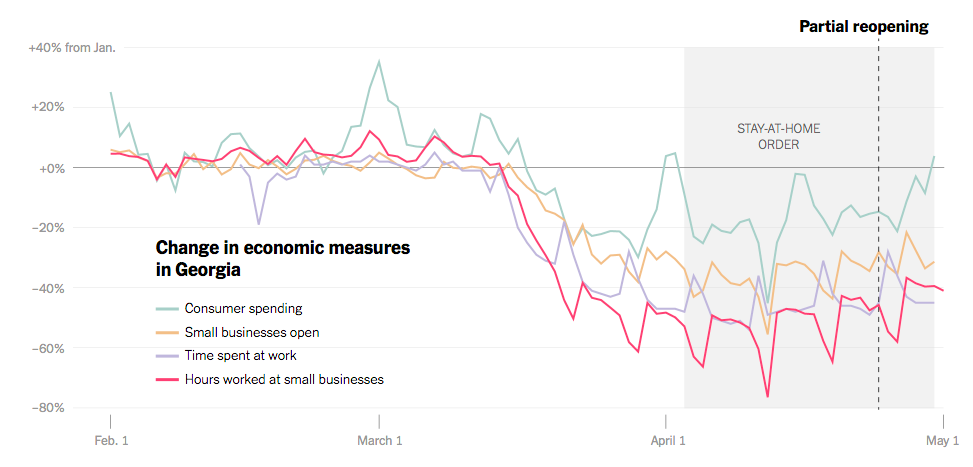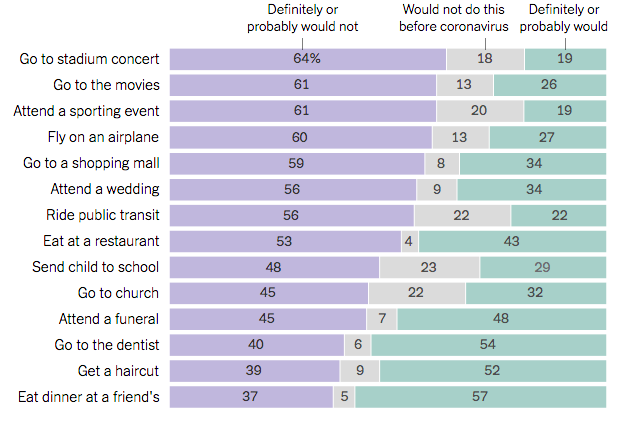Data shows there was a drop in spending and working even before any official mandates to stay at home.
In the weeks before states around the country issued lockdown orders this spring, Americans were already hunkering down. They were spending less, traveling less, dining out less. Small businesses were already cutting employment. Some were even closing shop.
People were behaving this way — effectively winding down the economy — before the government told them to. And that pattern, apparent in a range of data looking back over the past two months, suggests in the weeks ahead that official pronouncements will have limited power to open the economy back up.
In some states that have already begun that process, like Georgia, South Carolina, Oklahoma and Alaska, the same daily economic data shows only meager signs so far that businesses, workers and consumers have returned to their old routines.
Change in economic measures before, during and after state closures
Note: Change shown from Jan. 2020.·Source: Raj Chetty, John Friedman, Nathaniel Hendren and Michael Stepner, Opportunity Insights· The New York Times
Georgia, for example, began to reopen in waves starting April 24, first with gyms, salons and tattoo parlors, and several days later with dine-in restaurants and movie theaters. But the share of small businesses operating and the hours worked in them budged little through the following week, according to data from companies that help firms manage business and track payrolls, or that aggregate credit card transactions. The share of small businesses open remained down about 30 percent from January.
“There’s just no evidence that this partial reopening in Georgia has significantly changed anything in the economy,” said John Friedman, an economist at Brown University and a co-director of Opportunity Insights, a Harvard-based organization that is publicly tracking economic data on the crisis from a number of private companies. Consumer spending data in Georgia has fluctuated up and down, but moving averages of the metric have remained about the same.
Consumer spending data gathered by the project has not fallen as far as other measures of the health of the economy, partly thanks to tax refunds and federal stimulus checks that helped prop up spending in April. But daily measures of employment and store closings, particularly for small businesses, fell precipitously through March and have remained low.
Even in states that imposed stay-at-home orders or closed nonessential businesses relatively early, households and businesses had begun to shift their behavior about 10 days before those orders. In states that closed later, that shift had come about 20 days earlier.
Change in economic measures by timing of state closures
Note: Change shown from Jan. 2020. “Early closing states” include 14 states that issued stay-at-home orders and non-essential business closures during the week of March 19. “Late closing states” includes 14 states that issued some type of statewide order after March 26. In the eight states with no stay-at-home order statewide, other restrictions were in place.·Source: Raj Chetty, John Friedman, Nathaniel Hendren and Michael Stepner, Opportunity Insights· The New York Times
Across all of these states, most of the decline in these economic indicators occurred before official closure orders.
Even states that never put in a statewide stay-at-home order, like Iowa, South Dakota and Utah, saw significant drops in consumer spending and employment, as well as in the share of small businesses open.
This basic pattern is visible in other corners of the economy: Well before shutdown orders, restaurant reservations were plummeting. Electricity usage, which falls when office buildings and factories empty out, was dropping, too. Public transit in many cities was in free fall. So was the number of air travel passengers passing through T.S.A. checkpoints.
Such data, combined with opinion polling today, suggests that Americans who were turning off the economy on their own may not readily reopen it soon — even if officials say it’s OK to.
Weekly surveys of thousands of Americans by the Democracy Fund + U.C.L.A. Nationscape Project have found that a majority of Americans wouldn’t eat in a restaurant, go to the movies or return to a shopping mall even if they were now told they could.
If restrictions were lifted on the advice of public health officials regarding the following activities, how likely would you be to ...
Those findings in the Nationscape surveys are remarkably consistent across different groups. Residents of states that have already reopened or plan to soon are about as wary of these activities as residents of states that remain locked down, a pattern also found in polling by The Washington Post and the University of Maryland.
Among people in the Nationscape surveys who said they did these activities before the coronavirus crisis, Democrats are about eight to 12 percentage points more likely than Republicans to say they wouldn’t do them now. But those differences are far narrower than on many other polling topics today. Vast majorities of both groups say they would not ride public transit, attend sporting events or go on a flight. Majorities of both say they wouldn’t send their children back to school, a prerequisite to resuming many economic activities.
“Here’s this moment where almost everybody in the country agrees on a number of different things,” said Lynn Vavreck, a political scientist at U.C.L.A. working on the survey, and an Upshot contributor.
That is good news for political scientists who worry about partisanship amid a pandemic, and for public health experts who are urging caution as states begin to reopen. But for anyone hoping the economy will soon rebound, this picture may be more discouraging.
Significant shares of Americans — 30 percent to 40 percent — who say they oppose business closures and stay-at-home orders still report that they personally would not return to shopping malls, restaurants or church just yet. That means that many people who object on principle to government mandates will still be among those staying home once those mandates are lifted.
Source:Paper.li








